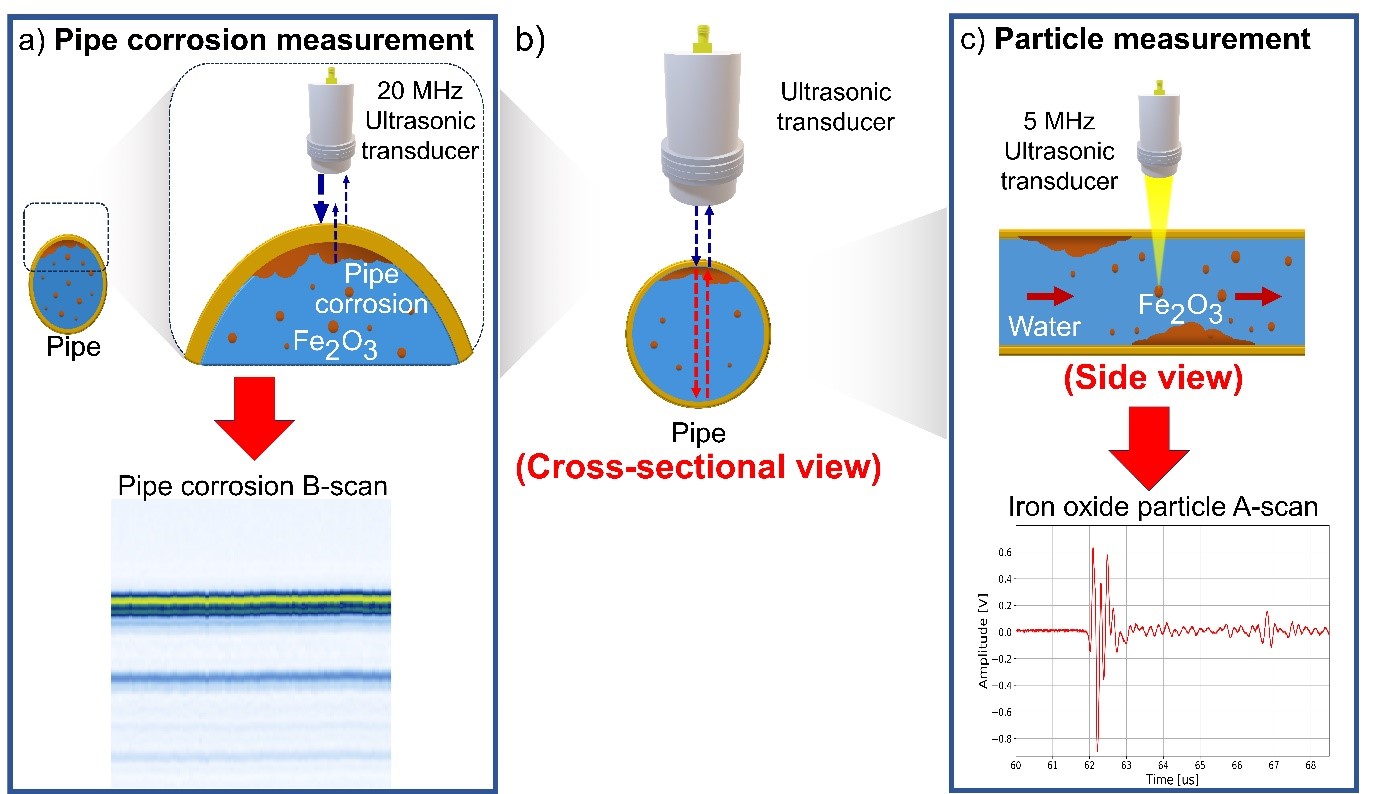커뮤니티
부경투데이
- 국립 부경대학교의 다양한 모습과 소식을 접하시면 부경대학교가 한번 더 가까워집니다.
| 네이처 자매지 실린 글로벌 연구(Global Research Published in a Nature Sister Journal) | |||
| 작성자 | 대외협력과 | 작성일 | 2024-07-28 |
| 조회수 | 6564 | ||
| 네이처 자매지 실린 글로벌 연구(Global Research Published in a Nature Sister Journal) | |||||
 |
대외협력과 |  |
2024-07-28 |  |
6564 |
국립부경대 임해균 교수팀, 글로벌 공동연구로 상수도관 초음파 이중진단시스템 개발
- 상수도관 부식 및 수질 동시 측정 … 네이처 자매지 <npj Clean Water> 게재

△ (왼쪽부터) 국립부경대 임해균 교수, 성영호 학사과정생, 가톨릭대 이오준 교수, 미국 Flowserve Corporation Hwan Ryul Jo 박사.
국립부경대학교 의공학전공 임해균 교수와 성영호 학생 연구팀은 가톨릭대학교 이오준 교수, 미국 Flowserve Corporation Hwan Ryul Jo 박사 연구팀과의 글로벌 공동연구를 통해 상수관 파이프의 부식과 파이프 내의 수질을 동시에 측정할 수 있는 시스템을 개발했다.
이 연구 성과를 담은 논문 ‘Internal pipe corrosion assessment method in water distribution system using ultrasound and convolutional neural networks’는 네이처 자매지 <npj Clean Water>(IF: 10.4, JCR 1.6% in Water Resources)에 최근 실렸다.
파이프 부식으로 발생하는 산화철 침전물은 물을 오염시켜 위장 감염, 피부 문제 및 림프절 합병증과 같은 심각한 건강 문제를 유발할 수 있고, 부식으로 파이프 벽이 약화하면 누수나 파열의 위험이 증가해 수리 비용 증가와 물 공급 중단을 초래할 수 있다.
이에 따라 파이프 상태를 조기에 파악하고 적절한 유지보수를 실시함으로써 수질을 보호하고 파이프의 수명을 연장할 수 있는 비파괴적이고 지속적인 부식 모니터링이 가능한 평가 방법이 요구돼 왔다. 기존 부식 평가 방법은 파이프를 훼손하거나 시스템을 중단시켜야 하는 경우가 많아 경제적 비효율성을 초래하는 한계가 있었다.
연구팀은 초음파와 인공지능을 이용해 비파괴적이며 지속적인 모니터링이 가능한 이중진단시스템을 개발했다. 고주파 초음파 현미경(SAM)을 활용해 고해상도 파이프 두께 이미지를 생성해 파이프 부식 정도를 모니터링하는데 성공했다. 동시에 합성곱 신경망(CNN)을 통해 배관 내 초음파 신호를 분석해 물속 산화철 농도를 측정하는 데 성공했다.
이 연구에서 부식으로 인해 69~80μm의 두께가 감소한 파이프를 고주파 현미경으로 측정한 결과 모두 5% 이내의 오차범위를 보였다. 또 파이프 내의 산화철 농도를 CNN을 이용해 분류한 결과, 최대 99%로 높은 정확도를 보였다. 이같이 파이프 부식 및 수질 분석이 가능한 이중진단시스템이 산업 현장에 활용되면 효율적이고 정밀한 파이프 인프라 관리가 가능할 것으로 기대된다.
임해균 교수 연구팀은 BK21 Four, 한국연구재단 우수신진연구지원사업, 지역혁신 선도연구센터(RLRC), 우수연구자교류지원사업(BrainLink) 등을 통해 이번 연구를 수행하고 지난 7월 13일 <npj Clean Water>에 논문을 출판했다. <부경투데이>

△ 초음파와 인공지능을 이용한 이중진단시스템 모식도.
Professor Lim Hae-kyun’s Team at Pukyong National University Developed Ultrasonic Dual Diagnosis System for Water Supply Pipes through Global Collaboration
- Simultaneous Measurement of Water Supply Pipe Corrosion and Water Quality... Published in the Nature Sister Journal <npj Clean Water>
Professor Lim Hae-kyun of the Biomedical Engineering Department at Pukyong National University and undergraduate student Seong Young-ho’s research team developed a system to simultaneously measure the corrosion of water supply pipes and water quality through global collaboration with Professor Lee O-jun of Catholic University and Dr. Hwan Ryul Jo from Flowserve Corporation, USA.
The paper titled ‘Internal pipe corrosion assessment method in water distribution system using ultrasound and convolutional neural networks ,‘ which contains the results of this research, was recently published in the Nature Sister Journal <npj Clean Water>(IF: 10.4, JCR 1.6% in Water Resources).
Iron oxide deposits resulting from pipe corrosion can contaminate water, leading to serious health issues such as gastrointestinal infections, skin problems, and lymph node complications, and if the corrosion weakens the pipe walls, the risk of leaks or ruptures increases, potentially resulting in higher repair costs and interruptions in water supply.
Accordingly, there has been a demand for an evaluation method that allows for non-destructive and continuous corrosion monitoring, enabling the early assessment of pipe conditions and appropriate maintenance to protect water quality and extend the lifespan of the pipes. Existing corrosion assessment methods often require damaging the pipes or interrupting the systems, leading to economic inefficiencies.
The research team developed a dual diagnosis system capable of non-destructive and continuous monitoring using ultrasound and artificial intelligence. They successfully generated high-resolution pipe thickness images using a high-frequency scanning acoustic microscope(SAM) to monitor the degree of pipe corrosion. At the same time, they analyzed ultrasonic signals in the pipes through convolutional neural networks(CNN) to measure the concentration of iron oxide in water.
In this study, pipes with a thickness reduction of 69?80 μm due to corrosion were measured using a high-frequency microscope, and all measurements showed an error margin within 5%. Additionally, the concentration of iron oxide in the pipes was classified using CNN, resulting in a high accuracy of up to 99%. It is expected that the dual diagnosis system capable of analyzing pipe corrosion and water quality will enable efficient and precise management of pipe infrastructure when applied in industrial settings.
Professor Lim Hae-kyun’s research team conducted this study through BK21 Four, the National Research Foundation of Korea’s Excellent Early-Career Researcher Support Project, the Regional Innovation Leading Research Center (RLRC), and the Excellent Researcher Exchange Support Project (BrainLink), and published their paper in <npj Clean Water> on July 13th. <Pukyong Today>